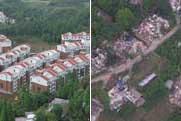China
Taikonaut to take China´s first step in space
BIG LEAP
Compared with the previous two manned space missions, the Shenzhou-7 faced unprecedented technical difficulties, said spokesman Wang.
 |
| Chinese taikonauts (L-R) Jing Haipeng, Zhai Zhigang and Liu Boming attend a departure ceremony in Beijing, Sept. 24, 2008. The Shenzhou-7 spaceship will carry the three taikonauts, all aged 42, for China's third manned space mission that will include the country's first-ever space walk.(Xinhua Photo) |
"EVA is a big leap for the manned space program," he said. China had made a series of technical breakthroughs, including the research and development of an EVA suit and an airlock module.
Chen Shanguang, commander-in-chief of the astronaut system, told Xinhua that the China-made EVA spacesuit costs 30 million yuan (about 4.4 million U.S. dollars) and can be worn by astronauts of 160 cm to 180 cm high.
The most complicated, advanced and expensive suit in the world, the EVA spacesuit provides a pressurized atmosphere, oxygen and temperature control for the astronauts. It also protects astronauts from radiation, micrometeoroids and other harmful particles in space. It also allows astronauts to communicate with others.
Chen said China spent less than four years in developing the EVA spacesuit and its design and assembling were done by Chinese scientists independently.
During the mission, taikonauts would need to assemble and test the EVA suits, depressurize and repressurize the cabin, exit and re-enter the orbital module.
"The process of extravehicular activities cannot be simulated completely on the ground and some of the newly developed products are to be tested in flight for the first time," Wang said.
"The capability and skills of the taikonauts and the quality of their operations directly determine the result of the mission," he said.
To ensure full-time monitoring during the EVA stage, China has added more ground monitoring stations and mobilized nine tracking ships and 30 planes. "The number of systems involved in the mission is unprecedented," Wang said.
International cooperation was an inevitable trend in manned space flights, which were large-scale projects with complex technologies and huge investment, Chen said.
China worked together with France and Belgium in several medical programs during the Shenzhou-6 space mission in 2005. It has set up four monitor stations abroad for the country's third manned spacecraft Shenzhou-7.
During the Shenzhou-6 space mission, joint research with Belgian space medical experts showed Chinese astronauts performed better than foreign astronauts in neural accommodation and staminain erect posture, said Li Yongzhi, deputy chief designer of the astronaut system.



